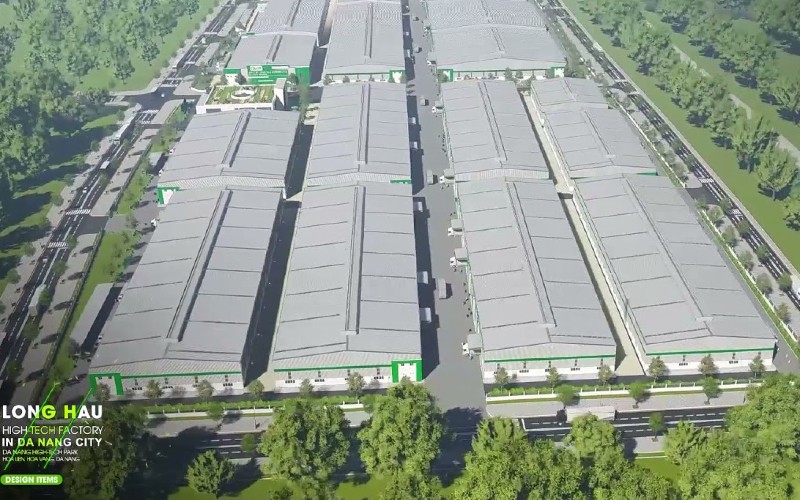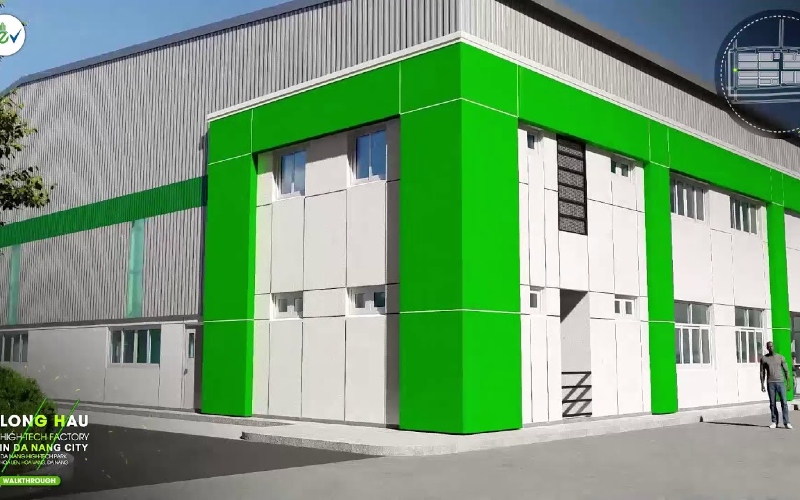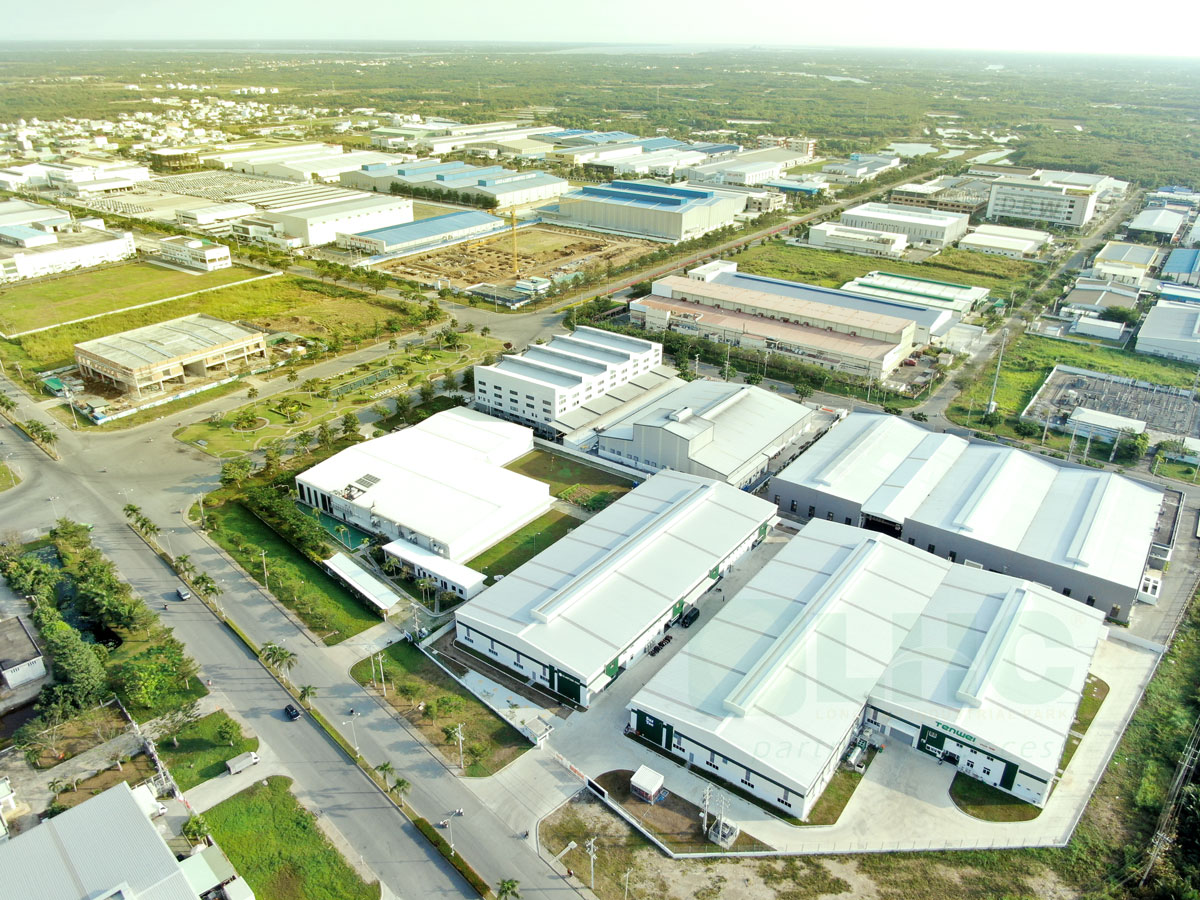
The modern market economy has made certain strides alongside social growth. Industry plays an important role in transitioning a nation from agricultural to industry toward modernity as part of the process of industrialization and modernization of the nation, helping to establish and develop industrial park Vietnam. How does the Vietnam Industrial Park grow? Read more about LHC in the article below!

Mục Lục
What is an industrial park? What’s the difference with the high-tech park?
What is an industrial park?
Industrial parks are places where factories and manufacturing facilities are situated for the large-scale production of goods and services. According to Decree No. 82/2018/ND-CP, an industrial park is a region with clearly defined boundaries that specializes in producing industrial goods and offering services for industrial production and is established in accordance with the requirements, regulations, and guidelines laid out in this Decree.
Currently, there are industrial parks in 63 provinces and cities. The following are some noteworthy characteristics of the industrial park:
- Nobody is allowed to live in industrial zones.
- An Industrial Park Management Board oversees each industrial park.
- The management board for the industrial park is a legal entity;
- Having a seal with the national anthem on it and an account;
- The state budget distributes funds to the Administration Board for state administrative management, non-commercial operations, and development investment capital in accordance with the annual plan and other funding sources as outlined by state agencies competent.
- The industrial park is focused on producing industrial products and providing support for that industry’s output. Consider logistics, the manufacturing of consumer goods, or the production of building supplies.
- Industrial parks are given special treatment, including corporate income tax exemptions and reductions, exemptions for land rentals,…

What is Hi-Tech Park?
The Prime Minister’s determination to conduct high-tech research, develop and deploy high technology, and incubate technology firms resulted in the establishment of high-tech park, a multi-functional economic-technical zone with predefined limits. According to Clause 3, Article 2 of Decree 99/2003/ND-CP, high technology includes developing high-tech human resources, producing and selling high-tech goods, and using high technology.
Industrial parks’ purpose and significance
Industrial parks are constructed with significant purposes and functions, contributing greatly to the nation’s building and socioeconomic growth. These regions will serve as a magnet for foreign investment.
Additionally, this is the primary organization in charge of making efficient and ethical use of the nation’s natural resources. Since then, the region’s assets will be utilized, elevating it to the status of a spearhead economy and fostering overall prosperity.
Vietnamese industrial parks possess the potential to attract foreign investors
Industrial zones in Vietnam have potential due to lower investment costs than the region
Most significantly, compared to other nations in the region, especially China, Vietnam’s industrial land prices are reasonable. While land in the northern part of Vietnam costs only 99 USD/m2/full lease term, industrial real estate in China can cost up to 180–200 USD/m2/full lease term. These factors help to explain why international investors are interested in Vietnam’s industrial real estate.
As foreign investment increases, Vietnam’s industrial zones are growing in number. In the entire country, 249 of the 326 industrial zones that had been established as of December 2018 were already in use. According to the Ministry of Planning and Investment, the occupancy rate was 73%.
Potential Vietnamese industrial park developed by FDI business community, easy trade connection
Foreign companies investing in Vietnam have been organized into associations of foreign companies by nation. In providing information on the legislation, market, business services, trade promotion support, dispute resolution, support, and reflection, associations play a full part. Numerous foreign businesses are investing in Vietnam. The Korean Business Association in Vietnam (Korcham), the American Chamber of Commerce in Vietnam (Amcham Vietnam), the Italian Chamber of Commerce (ICham), and others are working in the sector.
Industrial zones in Vietnam have been upgrading their infrastructure to meet international standards as the country continues to draw FDI. Improvements include better industrial parks overall, but investors should pay close attention to evaluating the standard of manufacturing facilities and warehouses, as well as the availability of water and electricity, wastewater treatment facilities, garbage disposals, fire suppression systems, improved telecommunications, access to banks and post offices, logistic services, and internal roads.
Preferential policies when investing in industrial parks in Vietnam
One of Asia’s most competitive tax systems is found in Vietnam. Industrial parks are being “excused from 2, reduced by 4”; that is, they are being exempted from corporate income tax for the first year and have their tax rate cut by 50% for the following four years. Even “4-free 9,” a 4-year tax exemption and a 50% tax discount over the following nine years are available for industry projects that the government prioritizes.
The expense for industrial zone services in Vietnam
The cost of an industrial park in Vietnam is classified into three categories, according the most recent information provided in “Investing Asia Industrial Park Guide” by Thanh Nien Publishing House:
– Area 1: $190 per month or VND 4,420,000
Dong Nai, Binh Duong, Ba Ria-Vung Tau, Hai Phong, Ho Chi Minh City, and Hanoi.
– Area 2: VND 3,920,000 ($ 168)/ month
Suburban Hanoi, Hai Duong, Hai Phong, Vinh Phuc, Bac Ninh, Hung Yen, Quang Ninh, Viet Tri – Phu Tho, Nam Dinh, Lao Cai, Ninh Binh, Thua Thien Hue, suburban Da Nang, Nha Trang, Da Lat, Dong Nai,Phan Thiet, suburban Binh Duong, suburban Ba Ria – Vung Tau, Ben Tre, Can Tho,Long An, Kien Giang, Tra Vinh, An Giang, Ca Mau.
– Area 3: VND 3,430,000 ($ 147)/ month
Suburban Hai Duong, suburban Vinh Phuc, Bac Giang, Phu Tho, Quang Ninh, Thai Nguyen, Lao Cai, Hoa Binh, Nam Dinh, Nghe An, Ha Nam, Thanh Hoa, Thua Thien Hue, Quang Nam, Quang Ngai, Khanh Hoa, Phu Yen, Lam Dong, Tay Ninh, Binh Phuoc, Ba Ria – Vung Tau, Tien Giang, Soc Trang, Hau Giang, Kien Giang and Ca Mau.
Difficulties in renting factories in industrial parks in Vietnam
Difficulties in price
Investors cannot afford the cost of renting a factory. The prices are also reasonable because high-tech parks frequently have more extensive and methodical investments in their infrastructure. Typically, the rent in other industrial zones in Vietnam is between $2 and $4 /m2/month. The cost per square meter per month in Vietnam’s high-tech major industrial zone will be between $5 and $6. Therefore, one of the challenges for organizations is related to price factors.
Difficulty in human resources
Vietnam deals with several difficulties. Vietnam offers an advantage when Chinese enterprises desire to relocate outside of China in order to reduce prices, but it lacks a highly skilled workforce. While labor costs in Vietnam are roughly a third of those in China, productivity is also only a third as high.
Vietnam has devised a strategy on human resource development to address the aforementioned issues, boldly hiring people, prioritizing investment in human resource training in high-tech fields, spearheading technology,… industries with high added value.
Difficulty in handling administrative procedures
For international businesses looking to grow their manufacturing operations in Vietnam, there are still several obstacles to overcome. The operating costs of these businesses will grow as a result of protracted administrative procedures and delays in customs clearance.
Vietnam will need to digitize and streamline its administrative processes. Vietnam has changed the way taxes are paid and has gradually loosened the rules for starting new firms, but these two reforms still need to be carried out.
Long Hau Industrial Park – Strategic area prioritizing industrial development
Long Hau Commune, Can Giuoc District, and Long An Province are the locations of Long Hau Industrial Park. With the following benefits, this Industrial Park has a lot of potential for future growth.
- Being at an advantageous location in terms of trade and transit of goods:
- In near vicinity to the network of international seaports, it is situated directly on a highway and traffic axis.
- Saigon – Hiep Phuoc Port and Saigon Central Container Terminal (SPCT) are all 3km away.
- Phu My Hung’s urban area is 12km away.
- Ho Chi Minh City’s downtown is 19km away.
- Tan Son Nhat Airport International is 25km away.
- Significant domestic and international investors to invest.
- More than 200 local and international investors have so far made investments in Long Hau Industrial Park. Vietnam’s industrial park combines urban and service elements.
Long Hau is one of the industrial parks built on the basis of an industrial-urban-service zone (both an industrial production zone and integrated with additional services: Business incubation center; research and development; Educational, cultural, medical facilities,…) and thus, it has a lot of potential for growth in the future.

Contact Info:
- Address: Hamlet 3, Long Hau Commune, Can Giuoc District, Long An Province
- Phone: (028) 3937 5599 – (+84) 906 938 599
- Fax: (028) 3781 8940
The information provided by Long Hau Corp regarding the industrial park is shown above. LHC sincerely hopes that these insights will be helpful to you. LHC appreciates your interest in this article.

Để lại một phản hồi